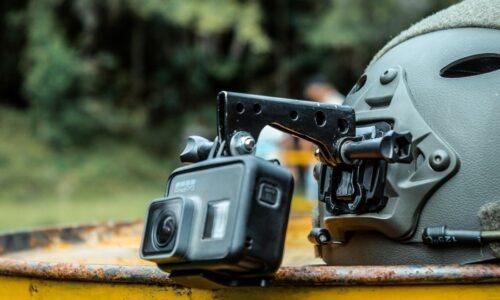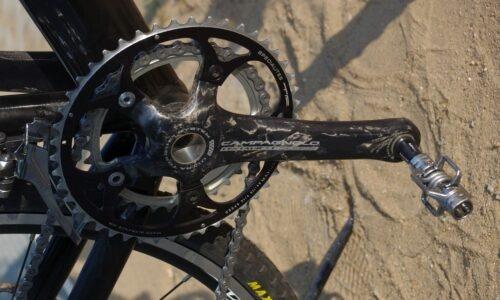Behind a quality frame, your wheels are arguably the next best thing to upgrade to improve your ride. Good wheels enable you to keep rolling, so they need to offer a smooth performance as well as be reliable to protect you against punctures and improve braking.
Your wheels also play a significant part in the weight of your bike and how aerodynamic it is.
Improvements can be felt in ride speed, braking ability, and lower weight. For road bikes, wheelsets are generally 700c and come in either disc or rim brake options.
Some are seriously expensive, but there are also some excellent options for all budgets. Here is our list of the bike road bike wheels, as well as what to look for when it comes to making a purchase.
Best road bike wheels for the money
Shimano Dura-Ace R9100 C24 Carbon Laminate Clincher Wheelset
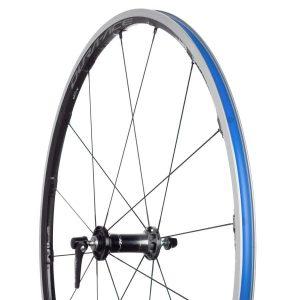 The Shimano Dura-Ace R9100 is made with reinforced polymer, bonded to a lightweight carbon fairing, and an alloy braking track, making it incredibly light at just 1,389g.
The Shimano Dura-Ace R9100 is made with reinforced polymer, bonded to a lightweight carbon fairing, and an alloy braking track, making it incredibly light at just 1,389g.
However, they are still very durable. That makes them fast and great for climbing. They don’t have a hugely deep rim and are 20.8 mm wide, but they are stable and reliable on longer rides and harsher conditions. They’re also compatible with 8, 9, 10 and 11-speed groupsets.
Pros:
- Supremely lightweight
- Great braking performance
- Shimano 8, 9, 10, 11-speed compatibility
Cons:
- Not the deepest rim
Mavic Ksyrium Elite UST
 For any mid-range bike, the Ksyrium Elite UST wheels will provide a big improvement in performance. They are tubeless-ready and offer a wider rim to suit 25mm tires. The bearings are good quality and the build is very reliable.
For any mid-range bike, the Ksyrium Elite UST wheels will provide a big improvement in performance. They are tubeless-ready and offer a wider rim to suit 25mm tires. The bearings are good quality and the build is very reliable.
At 1,520g they aren’t the lightest option available, but the price point is hard to beat. Mavic’s Cosmic Pro range is the next level up for racing so if you’re after a slightly faster set of wheels check them out.
Pros:
- Very well built
- Great value for money
Cons:
- Could have a wider rim
Best road bike wheels on a budget
Bontrager Aeolus Pro 3V TLR
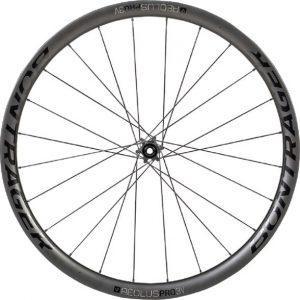 The Bontrager Aeolus Pro 3V TLR wheels measure 37mm deep, 25mm wide internally, and 32.6mm wide externally, making it perfect for higher-volume road tires.
The Bontrager Aeolus Pro 3V TLR wheels measure 37mm deep, 25mm wide internally, and 32.6mm wide externally, making it perfect for higher-volume road tires.
These carbon wheels are a leader in performance when it comes to road bikes. They are a fairly expensive option but perform incredibly well against similarly priced competitors.
They are also hand-built with 24 evenly tensioned spokes. Plus, they are tubeless-ready with Bontrager additionally providing tubeless rim strips and valves.
Pros:
- Modern, wide design
- Disc brake compatible
- Tubeless-ready
Cons:
- No 650B option, only 700c
Specialized Roval SLX 24 Disc
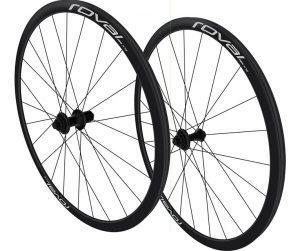 The Specialized Roval SLX 24 Disc wheels are far from a standard alloy clincher. They are at a lower price point and don’t look the nicest, but they provide excellent performance.
The Specialized Roval SLX 24 Disc wheels are far from a standard alloy clincher. They are at a lower price point and don’t look the nicest, but they provide excellent performance.
Weighing 1,562g is pretty good for tubeless-ready disc brake wheels, particularly at the price point. Additionally, the wide, rounded rims offer good tire profile, as well as grip and stability. These are a great all-round option without breaking the bank.
Pros:
- Lightweight
- Great value for money
- Good quality hubs
Cons:
- Not the nicest visually
- Not very aerodynamic
Hunt 30 Carbon Aero Disc
 These wheels are very competitively priced and very lightweight at just 1,340g with tubeless tape and valves in place.
These wheels are very competitively priced and very lightweight at just 1,340g with tubeless tape and valves in place.
The internal rim width is pretty wide at 27mm, providing a decent tire profile, and they are tubeless and disc brake ready.
Due to the weight, they are superb for climbing and the price makes them a very affordable but worthwhile upgrade.
Pros:
- Great price
- Very lightweight
- Really wide
Cons:
- A little soft through corners
Giant SLR1
 These traditional rim brake wheels have an easy tubeless setup and perform very well in most conditions. The wind barely affects them and descending speeds are good, making them a good all rounded.
These traditional rim brake wheels have an easy tubeless setup and perform very well in most conditions. The wind barely affects them and descending speeds are good, making them a good all rounded.
The wheels are very reliable, as you’d expect from Giant, without being overly flashy. At 1,463g they are also pretty lightweight.
You can probably pick up a cheaper set of aluminum wheels that offer the same performance, but if your heart is set on carbon wheels then they provide a reliable option at a good price.
Pros:
- Lightweight
- Easy tubeless set up
Cons:
- Rim brakes
Best high-end road bike wheels
Campagnolo Bora One 35 DB
 The Bora One 35 DB is fairly expensive but has superb acceleration speed, as well as stability.
The Bora One 35 DB is fairly expensive but has superb acceleration speed, as well as stability.
These wheels are optimized for 25mm and 28mm tires and use a more traditional rim shape than some of the more progressive options. However, they weigh 1,494g and are surprisingly comfortable.
These wheels also feature the Mega G3 spoke lacing pattern, which sets them apart visually.
The build quality is also excellent, as you’d expect from a market leader. If Campagnolo adds a slightly wider rim option then it’s the complete package.
Pros:
- Very fast
- Pretty lightweight
Cons:
- Narrow rims
Vittoria Qurano 46 Disc

These wheels are super, graphene-infused racing wheels. They are very stiff and surprisingly light. With a 16.5mm internal rim width, they don’t have the best tire profile but they do have an excellent build, elite finish, and impressive stiffness.
They weigh 1,514g and with a rim depth of 46mm, they are an excellent set of tubeless-ready disc wheels. They aren’t as expensive as other options of similar specs.
Pros:
- Impressive stiffness
- Nice finish
Cons:
- Narrow internal rim width
Fulcrum Racing Zero Carbon DB
 The Racing Zero Carbon DB has 30mm deep carbon rims, and they can be fitted with either clincher or tubeless tires.
The Racing Zero Carbon DB has 30mm deep carbon rims, and they can be fitted with either clincher or tubeless tires.
They are very fast, stiff, and responsive, making them ideal for most riding – racing, climbing, descending, and more. At 1,450g weight, they are very light. This is a superb but relatively expensive option for high performance.
Pros:
- Very fast
- Great for climbing
Cons:
- Rim width could be wider
How to pick your wheels?
Getting the right wheels can be difficult. Ultimately, you are looking for smooth-rolling, efficient and reliable performance. But you need to keep in mind what you are using your bike for.
Will you be racing? Doing a lot of climbing? Cycling long distances? These are the questions you should ask as different wheels are more suitable for different types of cycling.
Your bike wheel set up includes a tire, the inner tube, the rim, the hub, and the spokes. There’s a lot of variations for each, including more aerodynamic wheels for speed, tubeless wheels, and more.
Choosing the right wheels will improve your cycling efficiency as well as reduce the risk of punctures and mechanical issues so it’s important to consider these.
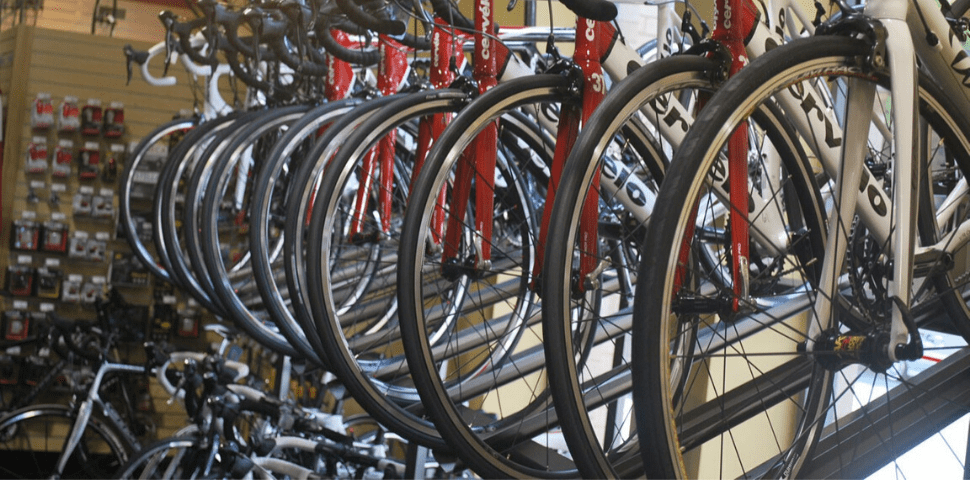
When it comes to budget, there’s a broad range for wheels. Top-level wheels, typically made with carbon fiber, can go for thousands, but you can get decent performance wheels for a few hundred. Remember, wheels are a long-term and worthy investment, and ultimately you get what you pay for.
The higher the price, the lighter, faster, and more robust the wheel would typically be. Cheaper wheels are often heavier, weighing between 1600g and 2000g for the set, and made with lower quality materials such as aluminum.
A more expensive set of wheels, such as a top of the range carbon fiber set (which can cost into the thousands), can be a lot lighter, weighing between 1400g to 1550g for the set. They’ll also have a better build finish.
Keep in mind wheel compatibility as some wheels are only compatible with certain setups, such as disc brakes or 11-speed chainrings. Market-leading wheelset brands include Shimano, Mavic, Fulcrum, Campagnolo, and Vittoria.
What you need to know about wheels
Your road bike will almost certainly use 700c size wheels. These are the most common for road biking as this size promotes efficiency, comfort, reliability, and handling.
The width varies depending on the tire and the wheel compatibility. The width of the rim enables you to have a greater choice of wider tires, which reduces the chance of puncturing, improves grip on corners, increases comfort, and promotes speed.
The wheel rims help determine durability, the overall rotating weight of the wheel, and how the bike responds to braking.
Generally, rims come in either shallow section (less than 25mm in depth), midsection (40mm or less in-depth), and deep section (anything deeper than 40mm).
When it comes to braking, there are two types of braking surfaces generally used on wheels: Aluminium and carbon. Aluminum provides the smoothest and more consistent braking surface, but in recent years carbon fiber braking surfaces have improved massively.
Traditional rim brakes have also been overshadowed by the popularity and performance gains of disc brakes.
Road bike wheel types
Shallow: Common on entry-level wheels, these are affordable and have a good strength to weight ratio, as well as being comfortable. Shallow section wheels are typically suitable for all-round performance.
Mid: Probably the least popular of the three types, midsection wheels provide a more lightweight rim and aerodynamic performance than shallow section, without the top speed of deep section. These wheels are light enough for climbing and fast enough for most situations.
Deep: Deep section wheels are for speed riding or racing. They are designed to slice through the wind at ease. That makes them more suited for flat, shorter cycling, but they can be suitable for climbing as well.
Tubular, clincher or tubeless wheels?
Tubular: Typically lighter than clincher wheels, these wheels require a tubular tire, which is more fiddly than a standard inner tube to change.
Tubular wheels require more preparation in terms of mounting the tire to the wheel. You can choose glue or tubular tape as a mounting method.
Clincher: Clincher wheels are the most popular type of wheels and offer the most all-rounder, affordable performance due to the convenience of installing tires and tubes.
They feature a bead seat on the rim which prevents the tire from leaving the rim, and the pressure inside the inner tube pushes the bead of the tire into the right position to give you a safe wheel.
Tubeless: Tubeless wheels have become more and more popular in recent years, and most of the major wheel brands have a tubeless wheel option. You can also see these wheels referred to as 2-way fit or two-way fit.
Tubeless wheels are typically slightly heavier than standard clincher wheels as there is additional material required on the rim to create the airtight seal for the special tubeless tires they use.
Tubeless tires, however, come with the massive advantage of no inner tubes, so you don’t need to carry or use inner tubes for fixing punctures. Also, ‘pinch’ punctures are less likely to happen due to the nature of the tubeless tire.
Key things to consider:
- The larger the wheel, the more comfortable the ride will be. 700c x 23 is the typical wheel size. The wider the rim, the better the tire profile.
- If the wheel is narrower, you’ll get less rolling resistance, which typically results in a faster ride. If you are worried about the weight you’ll choose a thinner wheel.
- Lighter, more expensive wheels (made with carbon) generally weigh between 1400g and 1550g.
- When it comes to performance, tread size, rim depth and width, weight, the spokes, and the tire profile all have an impact on speed, reliability, and efficiency.
- Different wheel options include tubular, clincher or tubeless wheels, as well as shallow, mid or deep-section wheels.

Founder of Vivi Nation, the cycling, running and active living brand. Chris is a sports enthusiast, occasional triathlete and experienced cyclist, having led multiple cycle tours across Europe.

